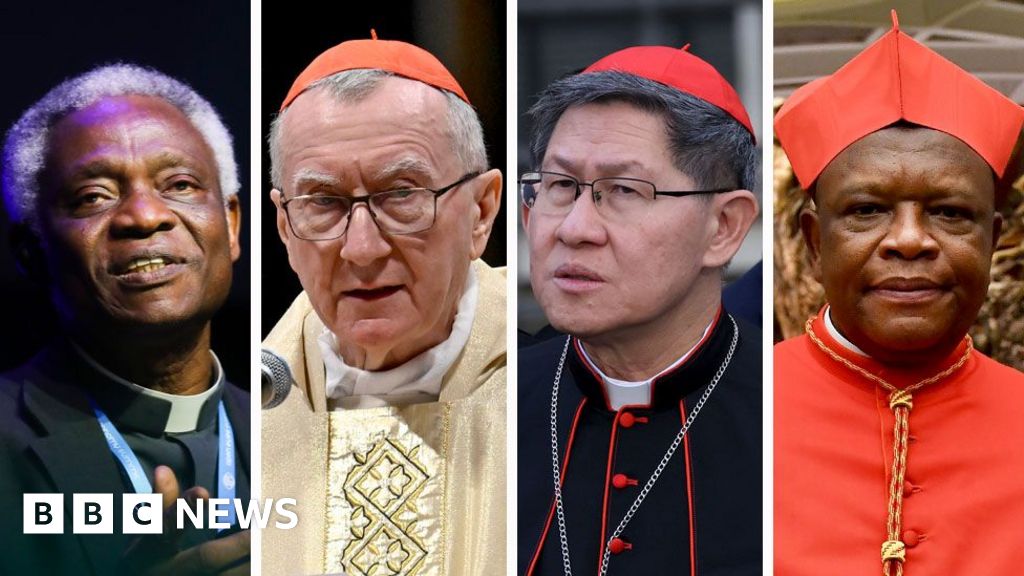Watch: Doorbell camera captures moment Palisades fire burns home
At least 16 people have died in the Los Angeles fires as two major blazes continue to burn across the sprawling Californian city.
Firefighters had made progress by Sunday - containing one smaller fire and nearly containing another - but the two largest blazes are still raging.
With strong winds expected to continue until Wednesday, the fire threat remains "very high", LA county officials said.
The fires are being marked as the most destructive in the city's history with officials warning the death toll could rise. Cadaver dogs and crews are continuing to search the scorched rubble of razed homes in neighbourhoods.
What's the latest?
The largest fire, in the Palisades, has now burnt through more than 23,000 acres although thousands of firefighters have made some progress in containing about 11% of it.
Crews were doing "everything they can" to stop its spread, said LA City Fire Chief Kristin Crowley on Sunday.
The blaze was moving east, threatening the exclusive neighbourhood of Brentwood, home to the Getty Center, a world-famous art museum that has now evacuated its staff.
Students at the nearby University of California, Los Angeles were also awaiting updates from officials, while classes are being held remotely.
Chief Crowley said favourable winds on Saturday had helped, but warned northerly gusts up to 50mph (80km/h) and low humidity were expected on Sunday.
A red flag warning - indicating a high level of fire danger - will be in place until 18:00 (02:00 GMT) on Wednesday, with the strongest Santa Ana winds expected on Tuesday.
Eleven deaths have been confirmed in the Eaton fire and another five in the Palisades fire.
Another 16 people are reported as missing.

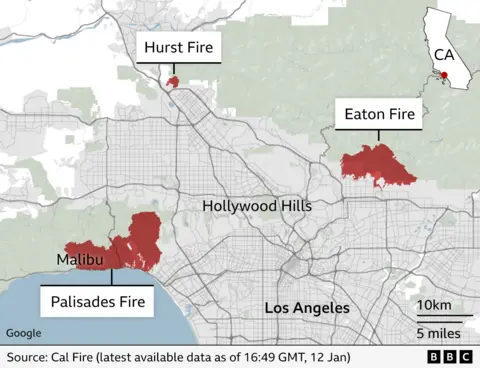
As of Sunday, more than 105,000 people were under evacuation orders in Los Angeles County, while another 87,000 face warnings. Those numbers have decreased since Saturday.
More than 12,000 structures - homes, outbuildings, sheds, mobile homes and cars -have been destroyed including 7,000 in the Eaton fire.
The Palisades fire has destroyed about 5,300 structures, including at least 426 houses.
Following reports of looting, authorities say they're also enforcing a curfew from 18:00 local time (02:00 GMT) to 06:00 within the areas affected by the Palisades and Eaton fires.

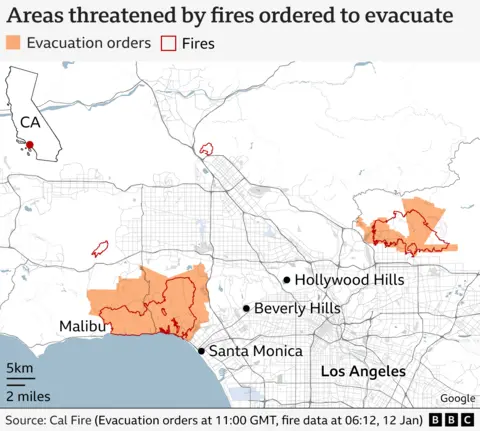
Police have so far made 29 arrests - 25 in the Eaton fire area and four in the Palisades fire zone. These included two individuals caught posing as firefighters and entering properties.
On Saturday night, police arrested one person for curfew violation in the Palisades and six people in Eaton - three for violating curfew and three for additional charges, including carrying a concealed firearm and narcotics-related charges.
About 400 National Guard members have been deployed to help with road closures and critical infrastructure. Moree were due to arrive on Sunday.
Utility company Southern California Edison also issued public safety power shutoffs - temporarily cutting electricity to reduce fire risk - to more than 26,000 customers in Los Angeles.
About 35,000 homes and businesses in the area were without electricity, according to Poweroutage.us, an outage monitor that tracks blackouts across the US.
LA county remains under a health emergency and smoke advisory, with people directed to stay inside to avoid air pollution.

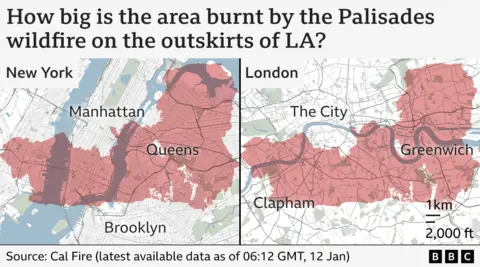
The fires could turn out to be the costliest in US history, with damage projected at up to $150bn, according to a preliminary estimate by AccuWeather.
Insured losses are expected to be above $8bn (£6.5bn) because of the high value of the properties damaged.
Celebrities who have lost their homes include Mel Gibson, Leighton Meester and Adam Brody, who attended the Golden Globes just days ago, and Paris Hilton.
Where are the fires?
There are two active fires in the wider area, while a smaller fire is nearly contained say California fire officials:
- Palisades: The first fire to erupt on Tuesday and the biggest in the region, which could become the most destructive fire in state history. It has scorched more than 23,654 acres, including the upmarket Pacific Palisades neighbourhood. It was 11% contained as of Sunday morning
- Eaton: Affectng the northern part of Los Angeles, blazing through areas such as Altadena. It is the second biggest fire in the area, burning more than 14,000 acres. It is 27% contained
- Hurst: Located just north of San Fernando, it began burning on Tuesday night. It has grown to 799 acres, and is almost fully contained
The earlier Kenneth, Archer, Sunset, Lidia, Woodley and Olivas fires have been contained.

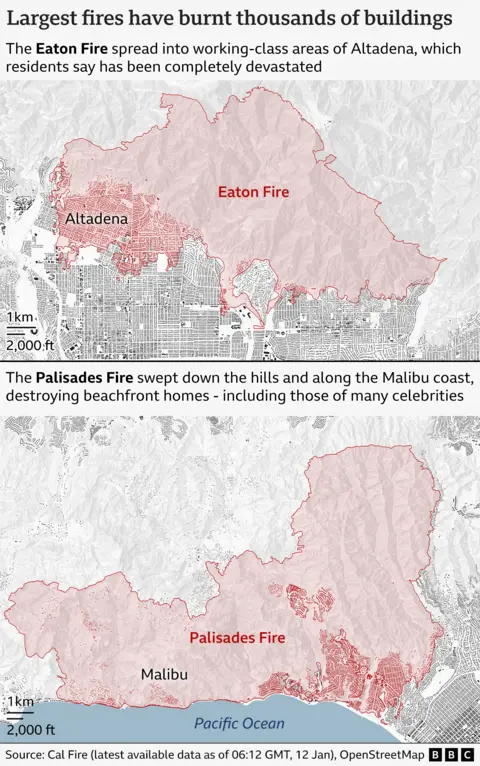
Was LA prepared for the fires?
A political row about the city's preparedness has erupted after it emerged some fire crews' hoses ran dry.
California Governor Gavin Newsom has called for an independent investigation into the loss of water pressure to hydrants and why the Santa Ynez Reservoir was closed for maintenance and empty when the fire broke out.
"Losing supplies from fire hydrants likely impaired the effort to protect some homes and evacuation corridors," he wrote.
Mayor Karen Bass returned to the city from a previously arranged trip to Ghana to find it on fire. She has faced intense questions about the region's preparedness, her leadership in this crisis, and the water issues.
On Saturday, she deflected questions about her handling of the emergency, telling a news conference: "Right now, our first and most important obligation to Angelenos is to get through this crisis."
Before the fires broke out, the city of LA's fire chief warned in a memo that budget cuts were hampering the department's ability to respond to emergencies.
Also on Saturday, LA County Fire Chief Anthony Marrone separately denied that his department had been unprepared.
"I did everything in my power to make sure that we had enough personnel and resources before the first fire started," he said.
"It wasn't for a lack of preparation or decision-making that resulted in this catastrophe. It was a natural disaster," Marrone added.
Dismay over the fire threat was worsened by alerts mistakenly sent to every mobile phone in Los Angeles on Thursday, residents say, prompting anger from some. About 10 million people live in the county.
During a news conference on Saturday morning, city authorities blamed a software glitch, which they said was "frustrating, unacceptable". They said they were changing their alerts system to partner with the California state emergency notification system.
What caused the fires?
Los Angeles County Sheriff Robert Luna said detectives are continuing to investigate the possible causes.
"Everything is absolutely on the table," he said.
Lightning - the most common source of fires in the US - has been ruled out as a cause for the Palisades and Eaton fires.
Nor has there been any official indication so far that arson or utility lines - the next two biggest culprits in sparking fires - caused any of the conflagrations.
California's very wet years of 2022-23 brought about a huge growth of vegetation, which dried out in the drought of last year, creating abundant kindling.
A combination of an exceptionally dry period - downtown Los Angeles has only received 0.16 inches (0.4cm) of rain since October - and powerful offshore gusts known as the Santa Ana winds have also created ripe conditions for wildfires.
BBC weather forecaster Sarah Keith-Lucas says there is no rain forecast in the area for at least the next week.
Although winds were expected to ease slightly later Friday into Saturday, forecasters warned that they would pick up again on Sunday into Monday.
Malibu seafront left devastated after wildfires
What role has climate change played?
Although strong winds and lack of rain are driving the blazes, experts say climate change is altering the background conditions and increasing the likelihood of such fires.
Much of the western United States including California experienced a decades-long drought that ended just two years ago, making the region vulnerable.
"Whiplash" swings between dry and wet periods in recent years created a massive amount of tinder-dry vegetation that was ready to burn.
US government research is unequivocal in linking climate change to larger and more severe wildfires in the western US.
"Climate change, including increased heat, extended drought, and a thirsty atmosphere, has been a key driver in increasing the risk and extent of wildfires in the western United States," the National Oceanic and Atmospheric Administration says.
Fire season in southern California is generally thought to stretch from May to October - but the governor has pointed out earlier that blazes had become a perennial issue. "There's no fire season," he said. "It's fire year."


 3 months ago
1407
3 months ago
1407


